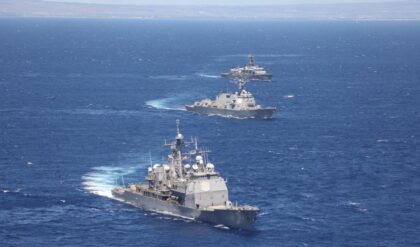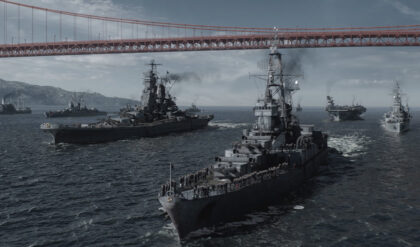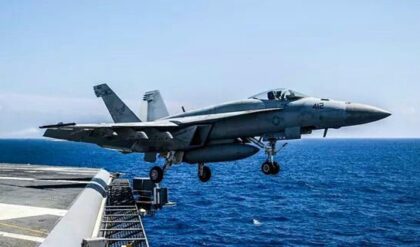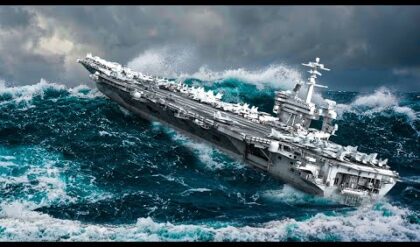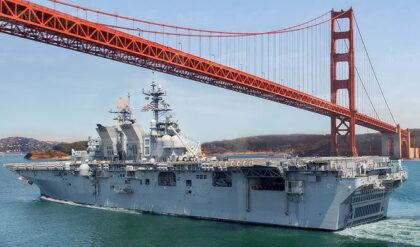In the world of naval aviation and naval warfare, few platforms stand out as emblematic of technological ability, prowess, and strategic importance as a super aircraft carrier.
The epitome of naval strength and projection, is portrayed by the USS Gerald R. Ford (CVN 78), which represents the technological state of the art of naval warfare.
Military Aviation Reachout managed to obtain an extraordinary unique opportunity to witness flight operations onboard this impressive vessel.






USS Ford Carrier OPS
MAR’s journey initiated onboard the C-2A Greyhound Carrier Onboard Delivery (COD), a crucial link in the critical logistical chain that binds the carrier group together.
Our team of photojournalists were flown from NAS Sigonella to the Ionian Sea where the carrier was operating as part of the SIXTH FLEET together with the rest of the Carrier Strike Group (CSG).
As you step onto the deck, you’re immediately struck by the controlled chaos that surrounds you. The roar of jet engines mixes with the salty sea breeze, creating an atmosphere charged with adrenaline and anticipation.
The deck itself is a complex puzzle of jet blast deflectors, catapults, arresting gear, and an exhibit of aircraft in various states of readiness.
At the heart of aircraft carrier operations are the flight deck crew, each performing their roles with astonishing precision.
Deck handlers in brightly colored vests wave to guide aircraft into position, ensuring they are perfectly aligned with the catapults.
The powerful catapult system is a masterpiece of engineering, accelerating aircraft from 0 to 160 miles per hour in a matter of seconds.
The synchronization between the deck handlers, catapult operators, and pilots highlights the rigorous training they undergo.
In the moments leading up to launch, our photojournalists could sense the intense tension. The aircraft’s engines roar to life, and as the pilot signals their readiness, the deck handler gives the signal to launch.
The aircraft lurches forward, and with a tremendous jolt, it’s hurled off the carrier’s deck and into the sky. It’s a breathtaking display of power and precision as the aircraft disappears into the distance.




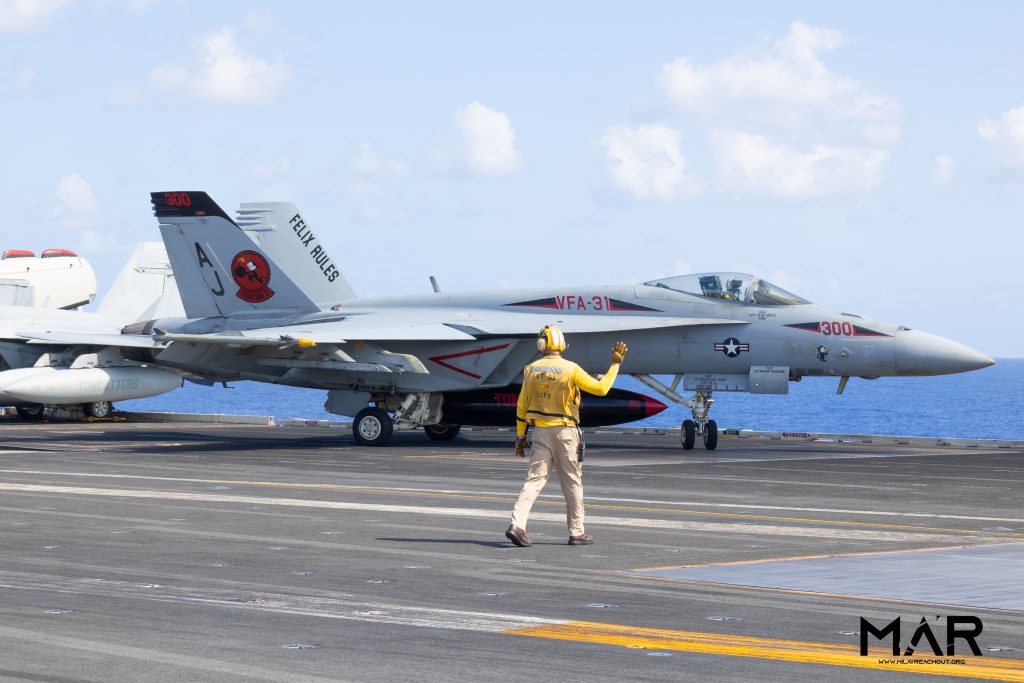












But the action doesn’t stop there. Aircraft recovery is an equally complex affair. As returning aircraft approach, the deck handlers ready themselves. The landing signal officer stands near the stern of the carrier, providing critical instructions to approaching pilots via hand signals and radio communication. The aircraft’s landing hook engages with one of the arresting cables on the deck, and the combination of the aircraft’s momentum and the arresting gear’s resistance brings it to a controlled halt in an impressively short distance.
In these moments, one can truly appreciate the tight spaces the crew works within. The deck is a complicated web of moving parts, yet every action is executed with meticulous care to ensure safety and efficiency. Aircraft are parked with inches to spare, and each movement is calculated to avoid collisions and maximize use of available space.
Experiencing these operations on the deck, helps one gains a profound respect for the men and women who operate in this high-stakes environment. Their teamwork, discipline, and skill transform the deck of an aircraft carrier into a perfectly choreographed stage where aircraft launches and recoveries are executed with maximum precision. It’s an experience that leaves you in awe of human capability and the wonders of today’s modern naval aviation.



A Glimpse into the History and Major Advancements
The history of aircraft carriers is one characterized by a continual pursuit of superiority. Named after the 38th President of the United States who dedicated his lifetime to the Navy’s service and served the country’s office from 1974-1977, the USS Gerald R. Ford is the lead ship of the Ford-class, boasting cutting-edge advancements that redefine naval capabilities.
Launched in 2013 and commissioned in 2017, this nuclear-powered supercarrier stands as a testament to innovation. Spanning over 1,000 feet in length and weighing approximately 100,000 tons, the USS Gerald R. Ford boasts a myriad of enhancements, including23 new technologies over its predecessors.
These include improved flight deck designs, featuring an electromagnetic aircraft launch system (EMALS), advanced arresting gear (AAG), and increased sortie generation rates (SGR) with 20% smaller crew than the Nimitz-class carrier.
These advancements collectively enhance operational reliability and flexibility, reduce maintenance requirements, and increase overall efficiency, reaffirming the United States Navy’s unwavering commitment to staying at the forefront of maritime dominance.
Central to its innovations is the Electromagnetic Aircraft Launch System (EMALS), a change from conventional steam catapults. EMALS employs electromagnetic fields to provide smoother and more controlled acceleration for aircraft during takeoff.
This enables the carrier to efficiently launch a wider range of aircraft sizes, from lightweight drones to heavy fighter jets, with precise control over the launch parameters and by doing so it reduces stress on both the aircraft and the carrier’s structure, thus requiring less maintenance compared to steam catapults.
Complementing EMALS is the Advanced Arresting Gear (AAG), a revolutionary system for aircraft recovery. AAG replaces the traditional arresting cables with energy-absorbing water turbines and an advanced control system. This innovation ensures a gentler deceleration during aircraft landings and safely brings landing aircraft to a stop.















Ford’s propulsion system has a substantial leap in efficiency and power generation. Its A1B nuclear reactors generate more than 25% additional electrical power compared to previous carriers.
This surplus power not only supports advanced systems like EMALS and AAG but also facilitates the integration of cutting-edge technologies such as directed energy weapons, electronic warfare systems, and future high-energy consumption equipment.
The electrical power distribution system of such a vessel generates almost three times the amount of electrical power from the previous Nimitz-class.
Moreover, the carrier’s island superstructure has been reimagined, incorporating an integrated mast housing various sensors, radars, and communication systems.
This design reduces the ship’s radar cross-section, enhancing its stealth capabilities and minimizing its vulnerability to enemy detection.
With approximately 140 feet further aft from the Nimitz-class, this allows more space on the flight deck to launch and recover aircraft.
In-deck fueling is another structural improvement that the Ford-class can refuel jets from the center of the flight desk, improving the ships’ ability to reload and relaunch aircraft.
On the defensive side, the USS Gerald R. Ford employs the Evolved Sea Sparrow Missile (ESSM) system, capable of intercepting and neutralizing incoming threats with improved accuracy and range.
The Rolling Airframe Missile (RAM) system provides an additional layer of protection, ensuring a formidable shield against a variety of aerial and missile threats.
Uncovering the Squadrons Onboard
Embarked upon the USS Gerald R. Ford are an array of elite squadrons, each contributing an integral piece to the carrier’s formidable prowess.
These squadrons encompass a spectrum of capabilities, ranging from fighter aircraft and airborne early warning to electronic warfare and maritime surveillance.
Each squadron’s distinct capabilities contribute to the symphony of naval might, showcasing the integrated teamwork that underpins the USS Gerald R. Ford’s mission of global projection and defense.
